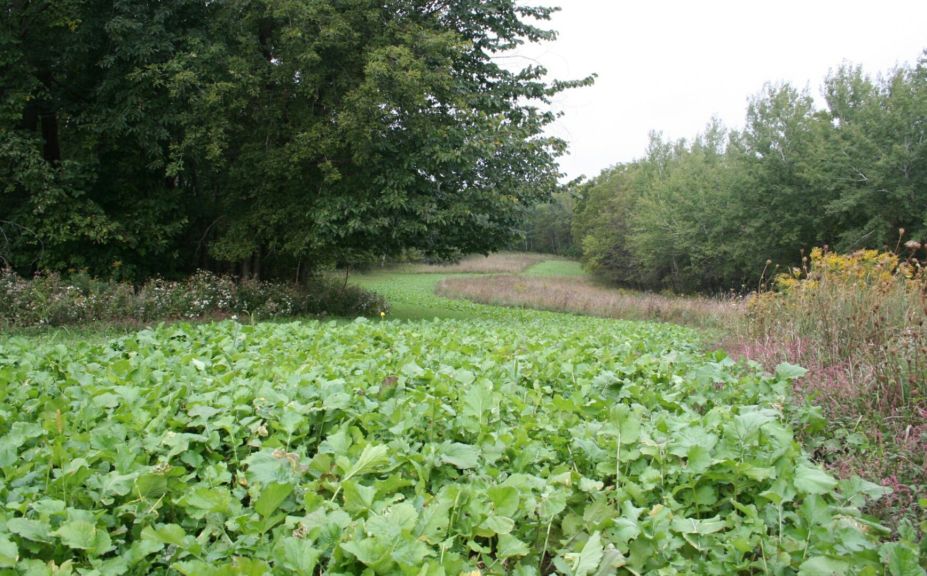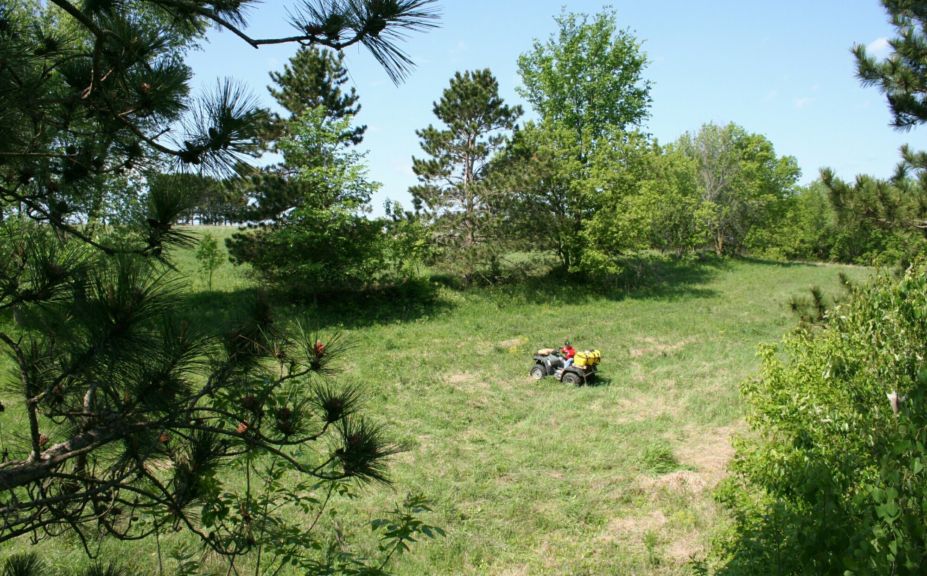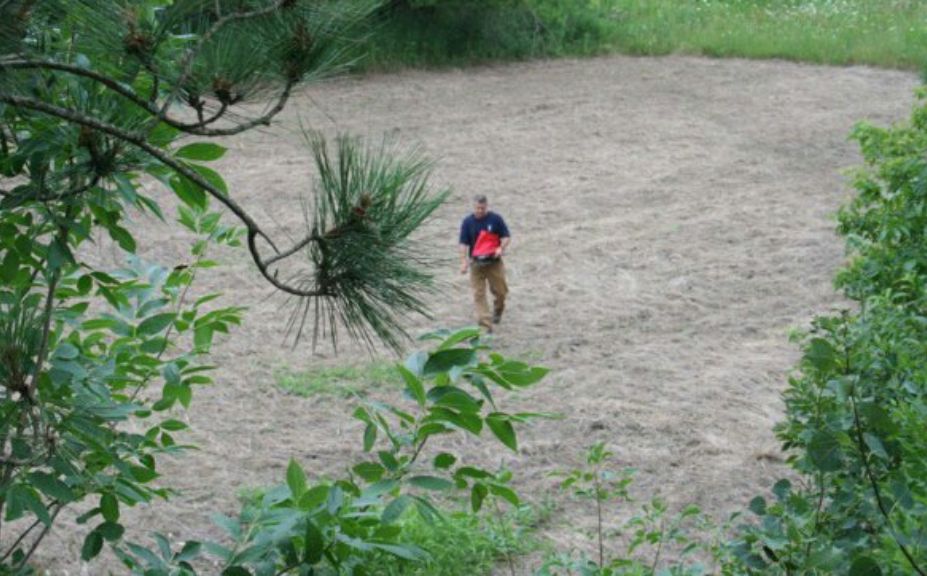No matter how big or small your food plot program is, you can expect success with this proven no till food plot method. Why? Because I first began using this method in 1999, and it hasn’t failed me yet. No disc? No tiller? No plow? No problem! Do you live hours away from your hunting land? You can still expect a very high level of success. I’m going to tell you how you can create beautiful fields of green with only a sprayer and a hand held broadcaster. Even if you own all the tools of luxury when it comes to food plot fun, you may just want to give your tractor a bit of a rest after reading about these planting strategies.

*Don’t forget to check out my trilogy of Advanced Whitetail Strategy books, including my food plot strategy book,“Food Plot Success by Design”.
Can you imagine having the best fields on the block during the peak of hunting season without ever touching a disc or tiller? Can you imagine a cool and warm season annual rotation with only an ATV or backpack sprayer and a hand-held spreader? If you care to push the envelope of small parcel food plot strategies, then proceed with an open mind and consider how these no till food plot practices that were first designed for the resource-challenged (me!), could potentially lead you to predictable success.
No Till Food Plot Necessities:
Would you believe in 2006 alone, I planted 18 acres of my own no till food plots in 3 States with this practice – with just an ATV, a hand held broadcaster and a 25 gallon ATV sprayer? From 2005 to 2013 My lease partners and I had six acres of plantings on our southwest Wisconsin lease, and those six acres played a critical role in both the hunting and herd potential of the parcel. However, we had no access to a tractor and lived 7 hours from the land. Six acres of plots may seem like a lot of plot acreage to create without traditional agricultural equipment, but it was actually extremely easy to prepare and plant all of the acres, with just a few timely hours of work every few weeks. Our efforts that began in the Spring, rewarded us with an ever-increasing deer herd as the hunting season progresses into early January, in particular when it came to the buck portion of the population. The six acres of plots provided a huge amount of September to April nutrition, which successfully covered a time of little nutrition in the whitetail woods. In addition, the food plots played an important role in building a high-quality herd by allowing us to protect bucks and “graduate” them into the next season, if desired.

*This October, 2006 no till food plot picture illustrates not only the potential effectiveness of the planting method, but the incredible amount of forage that can be created to a high volume of food at a time when the local ag fields and native habitat is quickly decreasing in forage value. This long, winding plot can also be used to create precision stand locations. To find out more, try reading, “Thin Is In, For Food Plot Designs”.
Easy Steps For A No Till Food Plot: Turning the clock back all the way to 1999, my annual no till food plot process began in the early Spring, when the various grasses and broadleafs were in their first aggressive growing phase. During the beginning of the annual Spring growing season, is the most important time to begin your food plots!
1. When the new growth of various weeds and grasses are 6-10″ and growing aggressively, it is time for your first of 3 total sprayings. Typically the timing of this spraying will be somewhere between April 15th and May 15th, depending on where you live in the North 1/2 of the country. I rely on a 2 quarts per acre spraying of 41% glyphosate solution for the first spraying. If you have particularly stubborn weed growth, it can be effective to add 1 pint per acre of a broadleaf-specific product (e.g., 2-4D) to this early Spring spraying. This first spraying of the year is the most important because it limits the future weed debris that can hinder seed to soil contact in the coming months. If the seeds that you eventually will plant are broadcasted on top of dead grass and weeds instead of soil, your no till food plot will not grow. A second and third spraying should be completed between 4 – 6 weeks apart with 1 quart per acre of glyphosate, instead of 2 quarts. After completion of the third spraying, a sufficient amount of soil should be exposed to begin planting activities. I like to time my sprayings to end by the latter half of July, so the plots are ready for a broadcasting of brassicas. This is too early to plant a single planting of wheat or rye, so I recommend that you return a last time to broadcast the small cereal grains around Labor Day. This produces a crop of fresh young growth that is timed perfectly for the opener of most State archery season.
-You may even have an area you want to develop into a food plot that contains early successional growth such as aspen or red willow. If young saplings exist, simply drive over them with your ATV, spray them, and let the glyphosate do its job. By late summer the trees will be nothing more than dried out and decaying branches with exposed soil underneath.
-Whether you are spraying into early successional growth or an abandoned field of native regeneration, I have a spraying rate that has worked exceptionally well since 1999. With a 25 gallon ATV sprayer I use 2 quarts per acre of glyphosate to kill 2 acres. I add the water first, and then add the glyphosate towards the end of filling the tank to mix the solution. Whether you are using a single or 2-nozzle sprayer on the back of the ATV, a speed of approximately 7-8 mph should apply the appropriate amount of herbicide with this setup. By starting with a smaller field of a 1/4 to 1/2 acre in size, you can apply the mixture at the recommended rate, check the tank to see how much spray is left, and then make adjustments in your speed if necessary.
-If an ATV isn’t currently in your budget, the sprayings can also be completed with a 4-gallon backpack sprayer. This approach involves a lot more walking and isn’t as efficient since you spend a lot more time repeatedly filling the backpack sprayer, but it works! I have used a ½ pint of glyphosate to kill one-eighth of an acre, and the results were the same as if I had used an ATV, so don’t be afraid to tackle a spraying and planting without the use of an ATV.

*This portion of the ag field had been fallow for years, while developing a significant amount of weed debris along the way. The first spraying for this 2007 no till food plot was critical for eliminating future weed debris, in an effort to promote adequate seed to soil contact. What should you plant this year? When choosing what to plant and why, make sure to read, “Food Plot Attraction Timing”.
2. My favorite brassica blend is simply broadcasted in late July onto the exposed soil, through the light covering of dead and decaying weed debris. The best planting practice that I have developed, is top create two halves of a food plot: One with a brassica base, and the other with a small cereal grain base. The brassica planting comes first, and over the years I have learned that you will be much more successful if you time the broadcasting of your favorite brassica combo immediately prior to forecasted rain of at least a 1/4″. Ideally, you should try to broadcast the seed blend when there’s a couple weeks of rain in the forecast. Even if dry weather forces you to wait 2-3 weeks longer than the ideal time to plant your brassica combinations in late July, it’s much better to wait than to plant early and receive zero rain. In addition, it’s best if you can time your plantings for approximately 10 weeks before the expected first frost in your area. A light drag and cultipacker can be used, but be careful not to cover the brassica seeds by more than a 1/4″ of soil. If rain is in the forecast, you may find that a light drag or cultipacker is not necessary. Also consider that light, dry, sandy soil may require a cultipacker or light drag, more than the moisture holding heavy soils that include a high percentage of organic matter or clay.
-In areas where the deer numbers are low, or deer seem to be finicky with brassica plantings, try adding 25 pounds/acre of soybeans and 50 pounds/acre of Austrian or Forage peas to your favorite brassica blend. In areas with light and poor soils, try 25-50 pounds/acre of buckwheat instead of the beans and peas. However, those seeds each require a covering of lite soil, so a drag or small disc could be required, in particular if heavy rains are not in the forecast. The only downside to using this technique to sweeten the planting is the possibility of heavy grazing. If you live in an area where the local deer herd browses on brassica plantings early and often, adding beans, buckwheat and/or peas to your planting will only magnify the intensity and frequency of the browsing pressure. If your plots receive high browsing pressure or poor growth and you’re left with a field of mostly soil, simply cover your brassica blend with a broadcasting of 200 pounds/acre of rye grain 2-4 weeks prior to your first frost date and enjoy the season.
-Brassica should not be planted more than two years in a row, in the same location, due to the possibility of disease build-up; so the two recommended base plantings of brassica and rye can and should be rotated to avoid any problems.
-Using only no-till planting methods can lead to soil compaction through repeated vehicle use on the planting surface. To combat this, I recommend a brassica base with at least 5 pounds/acre of tillage radish, which pushes an enlarged taproot into the soil a foot or more. Repeated freezes/thaw cycles in the spring will cause the rotted root system of the radish to fill with water, freeze, thaw and loosen the soil. The rotted root system also traps nitrogen within the soil, which can be greatly reduce the amount of fertilizer needed for the following year’s no till food plot rotations.

*Following the 3rd spraying of the fallow field in 2007, it was time to broadcast the brassica combo! However, should we have used this plot to hunt over? Not unless it met the requirements outlined in, “Precision Kill Plot Creations”.
3. After you have broadcasted your brassicas in late July or early August on the first 1/2, you can then return around Labor Day to plant cereal grain combinations directly alongside the earlier brassica plantings. When you return to broadcast your rye, wheat or both, the brassica portion of your no till food plot should be 4-8″ high, depending on rainfall. This 50:50 two-pronged approach will provide a nutritionally attractive offering in one location for a full four months or more. A hand-held broadcast spreader is the only tool you need for an effective basic planting of winter rye. I really like to broadcast a heavy planting, and with an Earthway Model 2750, vinyl bag spreader, you will find that you can pack about 30 pounds of rye into, and spread, with a rate of spread set to the largest opening. A full 200 pounds per acre of rye is not out of the question.
-Another approach to consider is a cereal grain combination planting. Your goal should be to establish a couple bases of plantings that will allow you to offer food for the entire hunting season and more. Since 1999, I have experimented with rye, oats, wheat, brassicas, buckwheat, clovers, chicory, peas, and soybeans in an effort to find the best possible combination of cereal grains. So what blend works best? All of them! In the case of very poor soils, a straight planting of rye may be your answer. In areas with great soil and low deer numbers, a huge variety of forages may be the best approach. In areas with high deer numbers, straight rye or wheat may again be the answer. In addition, you also have to consider the timing of your plantings. If you plant later than anticipated, plot sweeteners of peas, beans, buckwheat, or oats may not have enough time to develop into an appreciable crop. In contrast, an early planting of too much cereal grain has the potential to take over and lower the value of attraction on the plot. Each seed variety to be used, in combination with either a brassica or cereal grain base, has a purpose and strategy, so I encourage you to experiment with a purpose. One of my favorite cereal grain plantings that I now recommend the most, is as follows:
*Approximately 6-8 weeks prior to your projected first frost, lightly disc into the exposed soil 50 pounds/acre of oats and up to 100 pounds/acre of Austrian winter peas. Your goal should be to cover the seeds with Ľ to 1” of soil, followed by an immediate cultipacking. (In a pinch I have cultipacked with everything from lawn rollers, ATV and tractor tires, and vehicle tires.) *Two to three weeks later, broadcast 100 pounds/acre of winter rye, and two to three weeks after that, broadcast another 100 pounds/acre of rye right over the top of the fresh young growth. The intention here is to first establish the oats and peas which will be foraged on as soon as they germinate. Then, the two staggered plantings of rye will not only contribute to a variety of ages of growth for deer to enjoy, but will also create a substantial mat of forage. The goal is to produce a crop of cereal grains that is complimented by highly attractive peas and that produces enough growth to completely cover the soil.

*Beauty is in the eye beholder, so even though I missed a strip of weeds down the center of this 2007 no till food plot, it was “picture perfect”, because it was in the perfect location to accomplish our parcel goals. Are your plots located well? To make sure, try reading, “4 Advanced Food Plot Location Strategies”.
Is A No Till Food Plot Right For You?
I often tell my clients that if they are planting less than 10 acres, they can usually plant as efficiently with an ATV, hand-held broadcaster spreader, ATV sprayer, light disc and cultipacker while using no till food plot methods, as they could with a tractor and all of its implements. After planting hundreds of acres of successful no-till food plots for myself, across multiple states since 1999, I not only recommend these approaches to my clients, but I continue to personally rely on them for my own planting endeavors. One of my favorite aspects about designing client parcels is to design efficient, less expensive food plot programs that often save thousands of dollars or more in overall seed and equipment expense. Tractors certainly do have their place in the food plot world – especially for high-production corn and soybean plantings, deep discing or tilling, and plowing – but ATV no-till food plot options may offer the perfect solution to a more efficient and cost-effective program for your personal needs.
I feel the need to repeat, that your first spraying of the year is by far the most critical, because of the need to eliminate future weed debris. Your broadcasted seeds will not grow, if there is a layer of dead weed and grass debris between the seed and the soil. Ideally, your first spraying should take place when the weeds are only several inches high and growing aggressively, with moderate to warm temperatures.
I used to enjoy my tractor and all of its trimmings, but I haven’t missed it one bit, and I enjoy both the efficiency as well as the results. In fact, I found that by spending less time planting food plots, and more time focusing on stand locations, mature buck movements, and my overall approach to hunting, both my deer management and hunting success have increased. I encourage you to use your imagination to not only find no till food plot success, but the deer management and hunting opportunities that come with it.